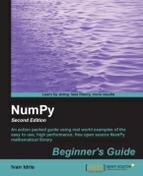The following code is an implementation of Game of Life with some modifications, as follows:
- Clicking once with the mouse draws a cross until we click again
- Pressing the r key resets the grid to a random state
- Pressing b creates blocks based on the mouse position
- Pressing g creates gliders
The most important data structure in the code is a two-dimensional array holding the color values of the pixels on the game screen. This array is initialized with random values and then recalculated for each iteration of the game loop. More information about the involved functions can be found in the next section.
- To evaluate the rules, we will use convolution, as follows.
def get_pixar(arr, weights): states = ndimage.convolve(arr, weights, mode='wrap') bools = (states == 13) | (states == 12 ) | (states == 3) return bools.astype(int)
- We can draw a cross using basic indexing tricks that we learned in Chapter 2, Beginning with NumPy Fundamentals.
def draw_cross(pixar): (posx, posy) = pygame.mouse.get_pos() pixar[posx, :] = 1 pixar[:, posy] = 1 - Initialize the grid with random values:
def random_init(n): return np.random.random_integers(0, 1, (n, n))The following is the code in its entirety:
import os, pygame from pygame.locals import * import numpy as np from scipy import ndimage def get_pixar(arr, weights): states = ndimage.convolve(arr, weights, mode='wrap') bools = (states == 13) | (states == 12 ) | (states == 3) return bools.astype(int) def draw_cross(pixar): (posx, posy) = pygame.mouse.get_pos() pixar[posx, :] = 1 pixar[:, posy] = 1 def random_init(n): return np.random.random_integers(0, 1, (n, n)) def draw_pattern(pixar, pattern): print pattern if pattern == 'glider': coords = [(0,1), (1,2), (2,0), (2,1), (2,2)] elif pattern == 'block': coords = [(3,3), (3,2), (2,3), (2,2)] elif pattern == 'exploder': coords = [(0,1), (1,2), (2,0), (2,1), (2,2), (3,3)] elif pattern == 'fpentomino': coords = [(2,3),(3,2),(4,2),(3,3),(3,4)] pos = pygame.mouse.get_pos() xs = np.arange(0, pos[0], 10) ys = np.arange(0, pos[1], 10) for x in xs: for y in ys: for i, j in coords: pixar[x + i, y + j] = 1 def main(): pygame.init () N = 400 pygame.display.set_mode((N, N)) pygame.display.set_caption("Life Demo") screen = pygame.display.get_surface() pixar = random_init(N) weights = np.array([[1,1,1], [1,10,1], [1,1,1]]) cross_on = False while True: pixar = get_pixar(pixar, weights) if cross_on: draw_cross(pixar) pygame.surfarray.blit_array(screen, pixar * 255 ** 3) pygame.display.flip() for event in pygame.event.get(): if event.type == QUIT: return if event.type == MOUSEBUTTONDOWN: cross_on = not cross_on if event.type == KEYDOWN: if event.key == ord('r'): pixar = random_init(N) print "Random init" if event.key == ord('g'): draw_pattern(pixar, 'glider') if event.key == ord('b'): draw_pattern(pixar, 'block') if event.key == ord('e'): draw_pattern(pixar, 'exploder') if event.key == ord('f'): draw_pattern(pixar, 'fpentomino') if __name__ == '__main__': main()You should able to view a screencast on YouTube at https://www.youtube.com/watch?v=NNsU-yWTkXM. The following is a screenshot of the game in action:

We used some NumPy and SciPy functions that need an explanation, as follows:
|
Function |
Description |
|---|---|
|
This applies the | |
|
This converts the array of Booleans to integers. | |
|
This creates an array from |
